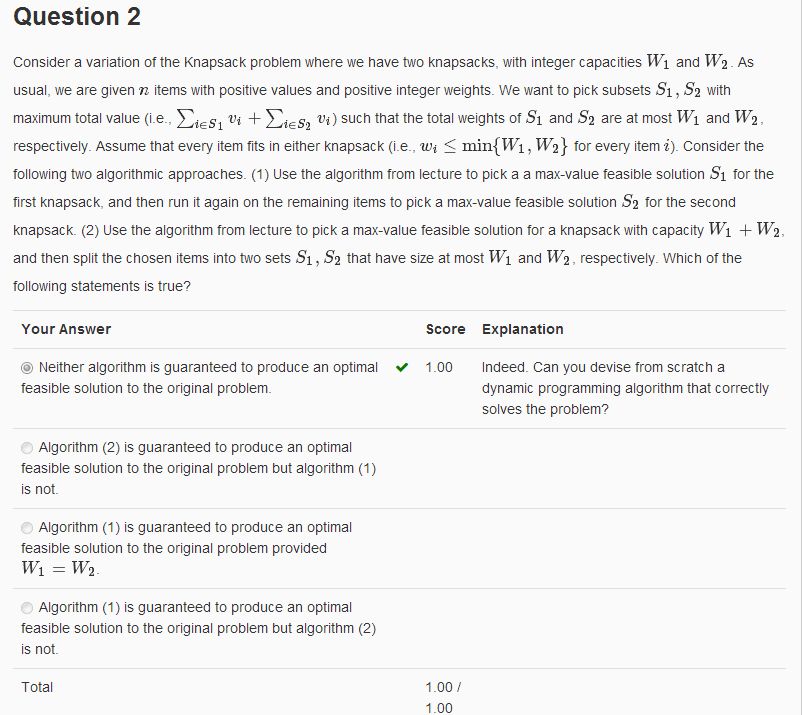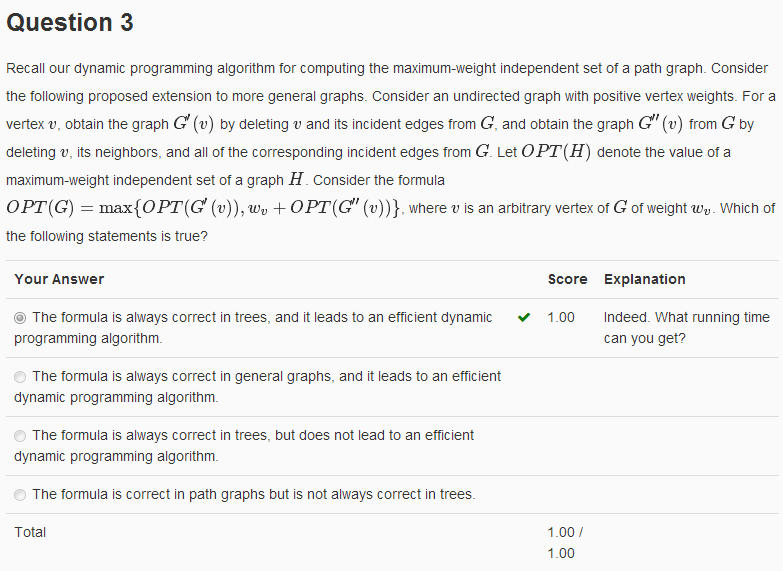分享一下我老师大神的人工智能教程!零基础,通俗易懂!http://blog.csdn.net/jiangjunshow
也欢迎大家转载本篇文章。分享知识,造福人民,实现我们中华民族伟大复兴!
Problem Set-3





Programming Assignment-3
Question 1
[knapsack_size][number_of_items]
[value_1] [weight_1]
[value_2] [weight_2]
...
For example, the third line of the file is "50074 659", indicating that the second item has value 50074 and size 659, respectively.
You can assume that all numbers are positive. You should assume that item weights and the knapsack capacity are integers.
In the box below, type in the value of the optimal solution.
ADVICE: If you're not getting the correct answer, try debugging your algorithm using some small test cases. And then post them to the discussion forum!
import java.io.BufferedReader;import java.io.IOException;import java.nio.charset.StandardCharsets;import java.nio.file.Files;import java.nio.file.Path;import java.nio.file.Paths;import java.util.ArrayList;/* * Question 1In this programming problem and the next you'll code up the knapsack algorithm from lecture. Let's start with a warm-up. Download the text file here. This file describes a knapsack instance, and it has the following format:[knapsack_size][number_of_items][value_1] [weight_1][value_2] [weight_2]...For example, the third line of the file is "50074 659", indicating that the second item has value 50074 and size 659, respectively.You can assume that all numbers are positive. You should assume that item weights and the knapsack capacity are integers.In the box below, type in the value of the optimal solution.ADVICE: If you're not getting the correct answer, try debugging your algorithm using some small test cases. And then post them to the discussion forum! */public class PS3Q1 { static int numItems; static int W;//size of knapsack static class Item{ int v; //value int w; //weight public Item(int v, int w){ this.v= v; this.w = w; } } /** * @param args */ public static void main(String[] args) { // TODO Auto-generated method stub int A[][]; Path p = Paths.get("knapsack1.txt"); ArrayList<Item> items = new ArrayList<Item>(); try { BufferedReader br = Files.newBufferedReader(p,StandardCharsets.UTF_8); String line = br.readLine(); numItems = Integer.parseInt(line.split(" ")[1]); W = Integer.parseInt(line.split(" ")[0]); while ((line = br.readLine())!=null){ int v = Integer.parseInt(line.split(" ")[0]); int w = Integer.parseInt(line.split(" ")[1]); items.add(new Item(v,w)); } A = new int[numItems][W+1]; for(int x =0;x<W+1;x++){ A[0][x] = 0; } for (int i =0;i<numItems;i++){ for(int x =0;x<W+1;x++){ int j = (i==0)?(0):(i-1); if (x<items.get(i).w){ A[i][x] = A[j][x]; }else{ A[i][x] = Math.max(A[j][x], A[j][x-items.get(i).w]+items.get(i).v); } } } System.out.println("Answer :: "+A[numItems-1][W]); } catch (IOException e) { // TODO Auto-generated catch block e.printStackTrace(); } }}Question 2
Download the text file here. This file describes a knapsack instance, and it has the following format:
[knapsack_size][number_of_items]
[value_1] [weight_1]
[value_2] [weight_2]
...
For example, the third line of the file is "50074 834558", indicating that the second item has value 50074 and size 834558, respectively. As before, you should assume that item weights and the knapsack capacity are integers.
This instance is so big that the straightforward iterative implemetation uses an infeasible amount of time and space. So you will have to be creative to compute an optimal solution. One idea is to go back to a recursive implementation, solving subproblems --- and, of course, caching the results to avoid redundant work --- only on an "as needed" basis. Also, be sure to think about appropriate data structures for storing and looking up solutions to subproblems.
In the box below, type in the value of the optimal solution.
ADVICE: If you're not getting the correct answer, try debugging your algorithm using some small test cases. And then post them to the discussion forum!

import java.io.BufferedReader;import java.io.IOException;import java.nio.charset.StandardCharsets;import java.nio.file.Files;import java.nio.file.Path;import java.nio.file.Paths;import java.util.ArrayList;/* * Question 1In this programming problem and the next you'll code up the knapsack algorithm from lecture. Let's start with a warm-up. Download the text file here. This file describes a knapsack instance, and it has the following format:[knapsack_size][number_of_items][value_1] [weight_1][value_2] [weight_2]...For example, the third line of the file is "50074 659", indicating that the second item has value 50074 and size 659, respectively.You can assume that all numbers are positive. You should assume that item weights and the knapsack capacity are integers.In the box below, type in the value of the optimal solution.ADVICE: If you're not getting the correct answer, try debugging your algorithm using some small test cases. And then post them to the discussion forum! */public class PS3Q2 { static int numItems; static int W;//size of knapsack static class Item{ int v; //value int w; //weight public Item(int v, int w){ this.v= v; this.w = w; } } /** * @param args */ public static void main(String[] args) { // TODO Auto-generated method stub int A[][]; Path p = Paths.get("knapsack2.txt"); ArrayList<Item> items = new ArrayList<Item>(); try { BufferedReader br = Files.newBufferedReader(p,StandardCharsets.UTF_8); String line = br.readLine(); numItems = Integer.parseInt(line.split(" ")[1]); W = Integer.parseInt(line.split(" ")[0]); while ((line = br.readLine())!=null){ int v = Integer.parseInt(line.split(" ")[0]); int w = Integer.parseInt(line.split(" ")[1]); items.add(new Item(v,w)); } A = new int[2][W+1]; for(int x =0;x<W+1;x++){ A[0][x] = 0; } for (int i =0;i<numItems;i++){ for(int x =0;x<W+1;x++){ int j = 0; if (x<items.get(i).w){ A[1][x] = A[j][x]; }else{ A[1][x] = Math.max(A[j][x], A[j][x-items.get(i).w]+items.get(i).v); } } //copy A[1] to A[0] for(int k = 0; k<W+1;k++) A[0][k] = A[1][k]; } System.out.println("Answer :: "+A[1][W]); } catch (IOException e) { // TODO Auto-generated catch block e.printStackTrace(); } }}给我老师的人工智能教程打call!http://blog.csdn.net/jiangjunshow
